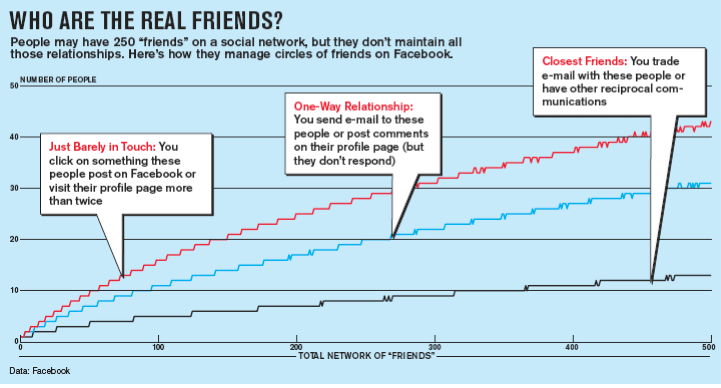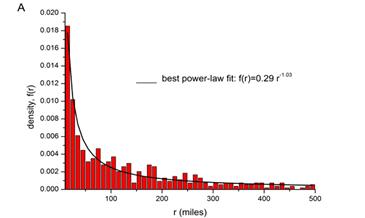Facebook’s Naked Reality: Social Networks Research Insights
It’s already an established phenomenon that in the social networking era friendship is more virtual and 6 degrees of separation has now been reduced to mere 3 degrees. However, seminal work of Dr. Robin Dunbar, an anthropologist, concluded that the cognitive power of the brain limits the size of the social network that an individual of any given species can develop. Extrapolating from the brain sizes and social networks of apes, Dr Dunbar suggested that the size of the human brain allows stable networks of about 148. Rounded to 150, this has become famous as “the Dunbar number”.
However the Dunbar number represents a person’s wider network. The actual number of individuals that represents his social “core network” with whom individuals “can discuss important matters”, numbers only 3 for Americans.
1. Do social networks increase the size of people’s personal networks?
Research findings of Dr. Cameron Marlow, the “in-house sociologist” at Facebook, suggests that the average number of “friends” in a Facebook network is 120, consistent with the Dunbar number.

Image Source: Business Week
Interesting to observe here that the number of people on an individual’s friend list with whom he (or she) frequently interacts is remarkably small and stable. For example, an average Facebook user—one with 120 friends—generally trades emails or responds to the postings of only 7 closets friends. But, as Facebook’s team reveals, social network interactions as taken at Facebook brings users to passively engage with 2-2.5 times more people in ones network (passive friends with whom a Facebook user maintains either ‘one-way relationship’ or ‘just barely in touch’).
2. Is online social networking as local as offline social networking?
Researchers at Hebrew University analyzed the messaging habits of 100,000 Facebook users by zip code & observed that the volume of e-mail traffic as a function of geographical distance follows an inverse power law i.e. the more local the sender-receiver, the higher the density of messages.

Our take :
![]() Highly interactive social platforms as Facebook can extend to a degree (“2x increase in connectivity”) the communication outside a person’s core network.
Highly interactive social platforms as Facebook can extend to a degree (“2x increase in connectivity”) the communication outside a person’s core network.
![]() Technology would continue enabling an environment conducive to ‘overshare‘, but we would still maintain a pattern of intimacy preferably with those who are located over shorter distance.
Technology would continue enabling an environment conducive to ‘overshare‘, but we would still maintain a pattern of intimacy preferably with those who are located over shorter distance.

Image Source: Universal McCann
![]() Tweet This Post
Tweet This Post ![]() Plurk This Post
Plurk This Post ![]() Buzz This Post
Buzz This Post ![]() Delicious
Delicious ![]() Digg This Post
Digg This Post ![]() Ping This Post
Ping This Post ![]() Reddit
Reddit ![]() Stumble This Post
Stumble This Post






![Validate my RSS feed [Valid RSS]](http://www.trendsspotting.com/blog/wp-content/images/valid-rss.png)


July 10th, 2009 at 7:46 am
very interesting, very insightful. Well done.
July 11th, 2009 at 1:13 pm
great analysis. In the tipping point Gladwell describes how that the “rule of 150” is used by corporation when they design building for large, to maintain some intimacy between co-workers. So the “tight-social-circle” average number is 3? that’s very interesting. Any cross-cultural study on that one?
July 12th, 2009 at 8:12 am
Thanks Hanan and Oren.
Indeed Peter Marsden found the number of people with whom individuals “can discuss important matters” is only 3 for Americans. Since this 1987 research, researchers report a further decrease (http://www.jstor.org/pss/30038995)-) but those results were criticized..
July 14th, 2009 at 1:02 pm
[…] 10, 2009 Facebook’s Naked Reality: Social Networks Research Insights It’s already an established phenomenon that in the social networking era friendship is more […]
July 29th, 2009 at 6:55 am
To be honest the “3” closest friends doesn’t surprise me as an average. If we’re talking ‘best friends’ share absolutely everything kind of close. It gets harder and harder to make those kinds of connections when you are an adult and have spouses, and children and careers to worry about. Maintaining and forming close friendships takes a lot of time and energy investment that we just seem to have less of as time goes on.
August 10th, 2009 at 2:26 am
as a global average those numbers are probably apt. But what was the selection criteria for the 100,000 subjects? Completely random?
Is there a system to establish the activity level of the users? Because leaving out the lapsed users or very infrequent users is probably what you need to do to get a better idea of the activity within the system itself…
April 10th, 2010 at 10:07 am
Twitter Comment
Analysis of the true use of facebook as a social-networking tool
[link to post]
– Posted using Chat Catcher
October 19th, 2010 at 4:57 am
OMG! This is really intriguing
October 19th, 2010 at 5:00 am
I never know that facebook is like this
October 19th, 2010 at 7:17 am
Nice post. Unbelievable how facebook change the way people socialize.
April 11th, 2011 at 1:19 pm
I’m ipmrseesd! You’ve managed the almost impossible.